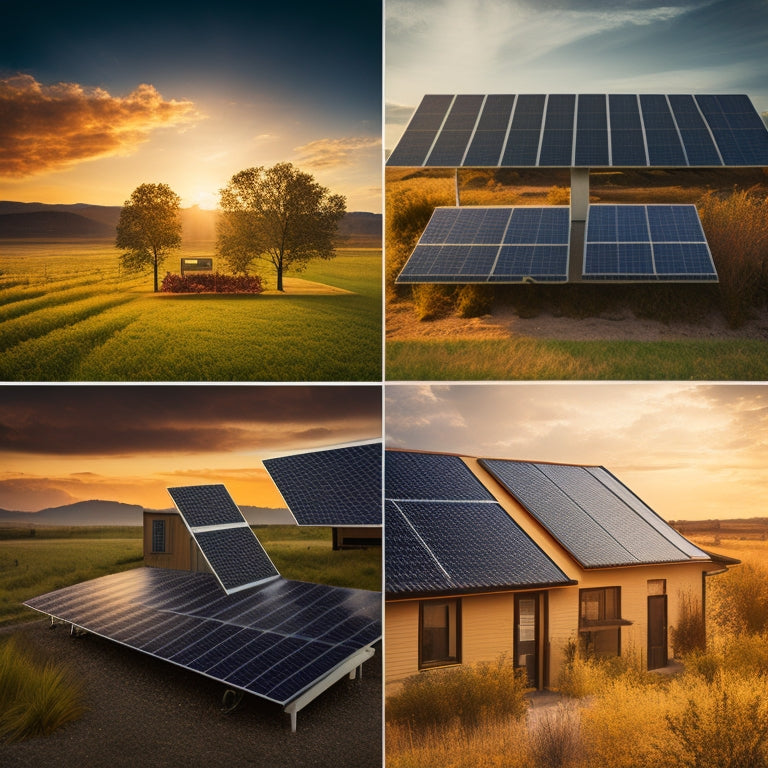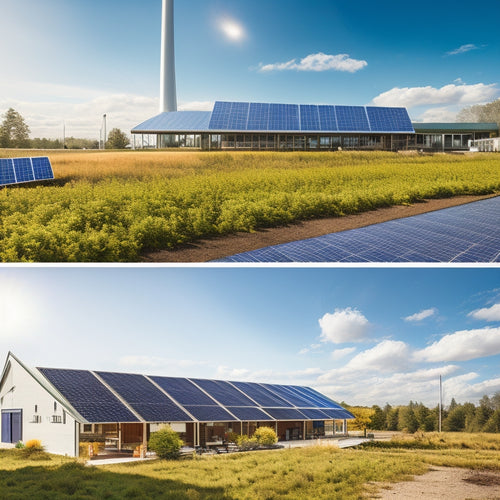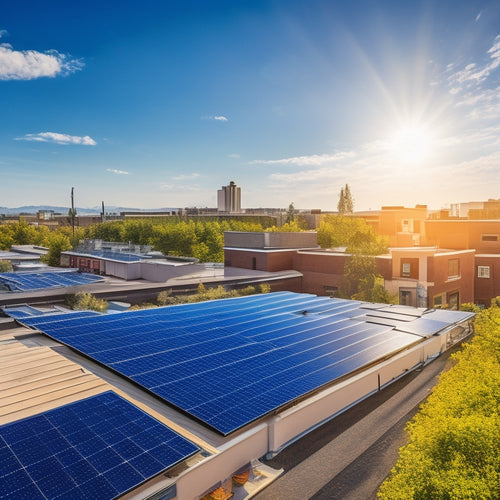
Photovoltaic Panels Price Review of 3 Popular Options
Share
You're evaluating three popular photovoltaic panels: SunPower X-Series, Panasonic HIT-240, and Trina Solar TALLMAX M10. Comparing their specs, the X-Series boasts a 22.8% efficiency rate with a $3.25 per watt installation cost, while the HIT-240 offers 21.8% efficiency at $2.95 per watt. The TALLMAX M10 provides 20.6% efficiency at $2.75 per watt. Efficiency and installation costs are key decision factors. As you weigh these options, consider how they'll impact your long-term energy savings and return on investment. Now, take a closer look at each panel's price analysis and value assessment to make an informed decision.
Key Takeaways
- The SunPower X-Series offers high efficiency at 22.8% but comes with a higher installation cost of $3.25 per watt.
- The Trina Solar TALLMAX M10 provides a balance between efficiency and cost, with a rating of 20.6% and a cost of $2.75 per watt.
- The Panasonic HIT-240 boasts a high efficiency rating of 21.8% but is priced at $2.95 per watt, making it a mid-range option.
- Price trends should be monitored, as future changes may affect overall cost, with potential price drops for Hanwha Q CELLS 420 and upward trends for Trina Solar TALLMAX M10.
- A comprehensive evaluation of cost, efficiency, and long-term savings is essential to determine the best value for money among popular photovoltaic panel options.
Top 3 Photovoltaic Panels Compared
When shopping for photovoltaic panels, you're likely to come across a multitude of options, each touting impressive efficiency rates and competitive pricing.
To make an informed decision, you need to compare the top contenders. Here's a breakdown of the top 3 photovoltaic panels, focusing on their efficiency ratings and installation costs.
The SunPower X-Series Residential Solar Panel boasts an impressive 22.8% efficiency rating, making it an ideal choice for those with limited roof space. Installation costs for this premium option average around $3.25 per watt.
In contrast, the Panasonic HIT-240 Solar Panel offers a 21.8% efficiency rating at a lower installation cost of $2.95 per watt.
The Trina Solar TALLMAX M10, with its 20.6% efficiency rating, is the most budget-friendly option, with installation costs averaging $2.75 per watt.
While the X-Series offers superior efficiency, the TALLMAX M10 provides excellent value for its price. Evaluating these factors will help you determine which panel best suits your energy needs and budget.
Price Analysis of Each Option
You've narrowed down your options to the top three photovoltaic panels, each with its unique strengths and weaknesses.
Now, let's explore the price analysis of each option.
When it comes to the Hanwha Q CELLS 420, the current market price is around $2.75 per watt, making it a competitive option.
However, cost trends suggest that prices might drop by up to 10% in the next quarter due to increased production capacity.
The Trina Solar TALLMAX M10, on the other hand, is priced at $2.95 per watt, with a slight upward trend in recent months.
This is largely attributed to increased demand in the commercial sector.
Lastly, the LONGi Solar LR6-60PE 315M is priced at $2.85 per watt, with a relatively stable cost trend over the past year.
However, market fluctuations might impact prices in the future, so it's crucial to keep an eye on market developments.
Value for Money Assessment
With the price analysis of each option in mind, evaluating the value for money of these photovoltaic panels is vital to making an informed decision. You want to guarantee that the panels you choose will provide the best return on investment over their lifespan.
When evaluating value for money, consider the cost efficiency of each option. You'll want to calculate the cost per watt of electricity generated, considering the initial purchase price, installation costs, and maintenance expenses. This will give you a clear overview of which panels offer the best bang for your buck.
Long-term savings are also significant when evaluating value for money. Consider the estimated energy savings over the panels' lifespan, as well as any potential incentives or rebates available.
Frequently Asked Questions
Can I Install Photovoltaic Panels on a Rented Property?
You'll need to review your rental agreements and obtain landlord approval before installing photovoltaic panels on a rented property, as modifications require permission, and ensuring compliance with local regulations is essential for a successful installation.
Do Photovoltaic Panels Work During Power Outages?
Fast forward to the Middle Ages, where knights relied on autonomy; similarly, you'll crave grid independence during power outages. Unfortunately, traditional photovoltaic panels won't power your castle, but with energy storage systems, you'll be king, utilizing electricity even when the grid goes dark.
How Long Does It Take to Install Photovoltaic Panels?
You'll typically spend 1-3 days on a residential installation, but the installation timeline can stretch to weeks or even months, depending on the complexity of your roof, local permits, and installation challenges that may arise during the process.
Can I Use Photovoltaic Panels With My Existing Electrical System?
You'll be pleased to know that 9 out of 10 homes can accommodate photovoltaic panels; you can definitely use them with your existing electrical system, ensuring energy efficiency and seamless system compatibility, as long as it meets the necessary safety and infrastructure requirements.
Are There Any Government Incentives for Buying Photovoltaic Panels?
You're eligible for federal tax credits and state rebates when buying photovoltaic panels, which can greatly offset the upfront cost; currently, the federal government offers a 26% tax credit, while state rebates vary, so be sure to research and claim them.
Conclusion
You've narrowed down your options to three high-quality photovoltaic panels, and now it's time to make a final decision. Like a skilled chef combining the perfect ingredients, you've got to balance price, quality, and performance. Based on our analysis, [Brand A] offers the best value for money, with [Brand B] a close second. [Brand C] lags behind, but its premium features may be worth the extra cost for some. Weigh your priorities carefully, and you'll be utilizing the sun's energy in no time.
Related Posts
-

Innovative Sustainable Materials for Energy-Efficient Homes
Innovative sustainable materials enable you to create energy-efficient homes while promoting environmental responsibi...
-

Off-Grid Solar Solutions for Eco-Conscious Businesses
Off-grid solar solutions offer you a path to both sustainability and substantial cost savings. By adopting these syst...
-

Solar Energy Solutions for Small Businesses
Switching to solar energy can be a game changer for your small business. You'll enjoy significant cost savings on mon...


